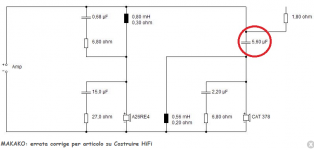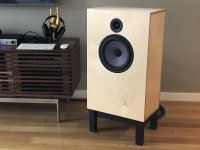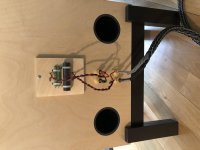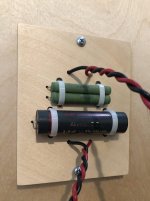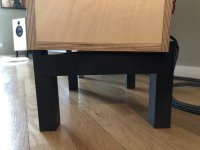Hi.
have a look here for this design:
MAKAKO (2 vie, bass-relfex, 8 Ohm, 300 Wmax)
After registration you can download the measurement files to play with...
Best wishes.
Frank
Frank,
Thanks!
Greg
That Makako design looks like it is in the right ballpark.
Not way different from the WD25EX Dynaco A25 idea:
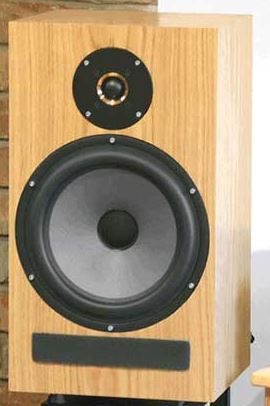
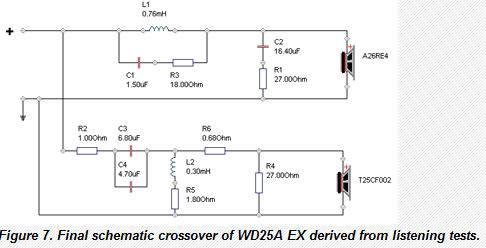
A little bit of bass contouring, quite a low 2kHz crossover, a small notch on the bass to align phase. Sort of thing you can tune by ear. The capacitor on the treble filter gets smaller with the waveguide added to a dome tweeter.
Not far from the orangutan idea:
DeVore Fidelity Orangutan O/96 loudspeaker Measurements | Stereophile.com
Whole thing based on a tidy bass driver. If any aspect is compromised, it is the very highest part of the top end. A mellow sound.
Not way different from the WD25EX Dynaco A25 idea:
A little bit of bass contouring, quite a low 2kHz crossover, a small notch on the bass to align phase. Sort of thing you can tune by ear. The capacitor on the treble filter gets smaller with the waveguide added to a dome tweeter.
Not far from the orangutan idea:
DeVore Fidelity Orangutan O/96 loudspeaker Measurements | Stereophile.com
Whole thing based on a tidy bass driver. If any aspect is compromised, it is the very highest part of the top end. A mellow sound.
Attachments
I have the A26 kit.Yup.
I still like the a26 kit.
Just have to slide the tweeter back for time alignment.
And use 3ft3 box (sealed) with felt inside.
Seas recommends "The cabinet stuffing (50g) is distributed evenly inside the box." I personally feel like its not enough. how much do you recommend in the A26 cabinet?
Ive also read from you that you recommend tilting the cab to "time-align" the drivers. do you think it would work well with the A26 cab?
thanks
if it sounds better to you, I'd say tilt it.
But I think you can "time align" it due to woof run wide open and single capped tweet.
Yes they are not perfect past crossover point, ideally both are an even 6db rolloff for maybe 2 octaves.
I and freddyi thought the b102/cat378 sounded better with the tweet and inch or 2 back.
Can't tell you on stuffing.
But I think you can "time align" it due to woof run wide open and single capped tweet.
Yes they are not perfect past crossover point, ideally both are an even 6db rolloff for maybe 2 octaves.
I and freddyi thought the b102/cat378 sounded better with the tweet and inch or 2 back.
Can't tell you on stuffing.
I have the A26
would it affect the A26 aperiodic loading or Q if I put 3 inch thick rockwool on the back wall of the speaker?
Seas calls for 50g of polyfill.
would it affect the A26 aperiodic loading or Q if I put 3 inch thick rockwool on the back wall of the speaker?
Seas calls for 50g of polyfill.
There are three things important to consider in building a design such ad this;
The tweeter crossover should be set at twice (or more) the tweeter's resonant frequency to avoid damage from overheating.
Woofers will 'beam' and become increasingly directional as the frequency they reproduce increases. This paper driver is well behaved because of the heavy composition.
These benefit from careful placement in corners, at some distance from the listener and are NOT the most revealing monitors
They can be very musical, and are relatively easy to build.
I've made the simplest A26 kit, which runs the woofer full range. It was tolerable, but not great. I highly recommend consideration of the more advanced crossover designs that are detailed above.
If you can find a pair of Snell Type E or Dynaco A25 for a 'test drive', audition them first.
In my opinion, this design has many unnecessary compromises given available drivers at similar cost.
hi
I have the A26 kit, what XO did you ended up preferring over the simple no xo on woofer and 1st order on the T35?
That Makako design looks like it is in the right ballpark.

I've got a pair of used T25CF002 with new diaphragms installed and not used, at a very good price if needed, they looks like new.
Curiously, many diy designers with fancy designs never discuss what should go behind the driver. I use a hybrid of design and materials to attenuate the back wave. The back wave is the same energy as the front, yet hardly ever mentioned in a design
Yep, and most of it can simply re-emerge through the woofer cone, which (compared to the enclosure walls) is acoustically transparent.
Experiments to investigate this:
Post 52 here:
Innerchoic cabinets - should I?
Post 127 here:
Measuring sound output from speaker cabinet walls
Would love to get some ideas about which tweeter to pair with the A26RE4 in a two way design similar to the O96. I was thinking of trying the Morel SUPREME ST1108.
dualuxe. the reason most of us like to know your location, is because we like to know what is locally available at a good price. Earth is a bit vague, isn't it? AFAIK, unless you are on the space station, Earth it is! 😀
Time for a review:
This is the Peter Comeau WD25A version of the SEAS A26 kit:

What he did there was use a smaller tweeter. The SEAS T25CF002: E0011-06 T25CF002

There is some confusion here between two versions of a theme, one with a big box, and one with a smaller one, but as someone who can read a crossover like other people read Egyptian Hieroglyphics, I can tell you that bass filter does next to nothing. The SEAS T25CF002 tweeter is not a huge difference to the expensive Morel SUPREME ST1108, IMO. Both essentially 1" soft domes on a flat faceplate.
Of course, this is not quite a John DeVore Orangutan O/96. A waveguide tweeter, maybe a Morel CAT378, is a slightly different animal. John has also redesigned the SEAS A26 with a phase plug.
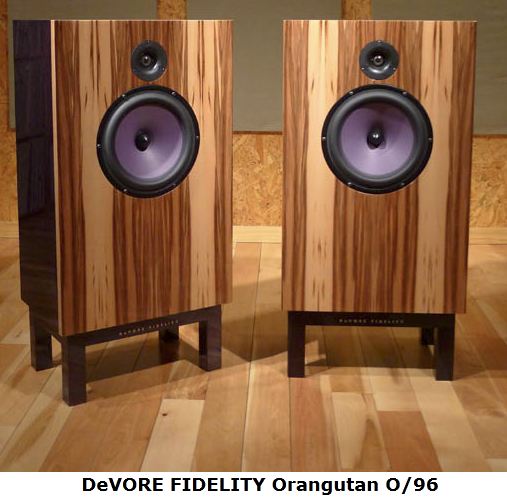
But same ballpark.
My feeling is the waveguide Morel CAT378 is extremely affordable, delivers lower distortion at the bottom end, albeit with narrow dispersion, so is rather good. Especially since a 10" midbass is rather weak on dispersion too. Maybe a happy match. Of course, you listen on-axis to avoid dispersion problems.
The Orangutan 0/96 is a bit of a throwback to the golden-age of valve amplifiers. It does certain things very well. Perhaps high-efficiency is the main thing. Along with low mechanical loss.
Time for a review:
This is the Peter Comeau WD25A version of the SEAS A26 kit:
What he did there was use a smaller tweeter. The SEAS T25CF002: E0011-06 T25CF002
There is some confusion here between two versions of a theme, one with a big box, and one with a smaller one, but as someone who can read a crossover like other people read Egyptian Hieroglyphics, I can tell you that bass filter does next to nothing. The SEAS T25CF002 tweeter is not a huge difference to the expensive Morel SUPREME ST1108, IMO. Both essentially 1" soft domes on a flat faceplate.
Of course, this is not quite a John DeVore Orangutan O/96. A waveguide tweeter, maybe a Morel CAT378, is a slightly different animal. John has also redesigned the SEAS A26 with a phase plug.
But same ballpark.
My feeling is the waveguide Morel CAT378 is extremely affordable, delivers lower distortion at the bottom end, albeit with narrow dispersion, so is rather good. Especially since a 10" midbass is rather weak on dispersion too. Maybe a happy match. Of course, you listen on-axis to avoid dispersion problems.
The Orangutan 0/96 is a bit of a throwback to the golden-age of valve amplifiers. It does certain things very well. Perhaps high-efficiency is the main thing. Along with low mechanical loss.
Last edited:
any seas soft dome about 90 db efficiency will workWould love to get some ideas about which tweeter to pair with the A26RE4 in a two way design similar to the O96. I was thinking of trying the Morel SUPREME ST1108.
I kinda like the T-35 tweeter in my seas a26 but if you dont plan on using a 1st order xo, i think its slightly overpriced
So I finally got around to prototyping this speaker and wanted to share my results with the DIY crowd here. A few photos are attached.
What I ended up with is the result of a lot of crossover and port length experimentation and listening. I am very pleased with the outcome and will eventually get around to building a new cabinet in a Devore style with some special veneer and a base made from hardwood.
Drivers are the Seas A26RE woofer and Morel CAT378 tweeter. They are individually wired to terminals on the back baffle so I could experiment with the crossover without opening the cabinet.
The crossover is a first order high pass on the tweeter with a 3.9 uF cap and an L-pad attenuation of R1 = 2.7 ohm and R2 = 15 ohm. I also experimented with a second order high pass but found the first order and a relatively higher crossover frequency sounded better.
The prototype cabinet is built from 19mm baltic birch plywood and measures 18"W x 29"H x 11.5"D. Since this is just a prototype, I finished the baltic birch with a few coats of satin lacquer.
I used a piece of 1x3 poplar as a brace between the front and back baffles about 3" beneath the woofer. On the back baffle directly behind the woofer is a 1" thick 6 pound fiberglass panel measuring about 14" square to reduce reflections back through the woofer. The remainder of the back baffle and the top, bottom and side walls are covered with 1.5 pound pink fiberglass. The dual ports are 3" ABS pipe 7.5" long.
The prototype base is made from poplar and measures about 7.5" high in the front. You will see in the photos that the front legs are arranged to tilt the cabinet back by about 3 degrees. This points the acoustic center of the woofer/tweeter directly at my listing position about 13' away.
What I ended up with is the result of a lot of crossover and port length experimentation and listening. I am very pleased with the outcome and will eventually get around to building a new cabinet in a Devore style with some special veneer and a base made from hardwood.
Drivers are the Seas A26RE woofer and Morel CAT378 tweeter. They are individually wired to terminals on the back baffle so I could experiment with the crossover without opening the cabinet.
The crossover is a first order high pass on the tweeter with a 3.9 uF cap and an L-pad attenuation of R1 = 2.7 ohm and R2 = 15 ohm. I also experimented with a second order high pass but found the first order and a relatively higher crossover frequency sounded better.
The prototype cabinet is built from 19mm baltic birch plywood and measures 18"W x 29"H x 11.5"D. Since this is just a prototype, I finished the baltic birch with a few coats of satin lacquer.
I used a piece of 1x3 poplar as a brace between the front and back baffles about 3" beneath the woofer. On the back baffle directly behind the woofer is a 1" thick 6 pound fiberglass panel measuring about 14" square to reduce reflections back through the woofer. The remainder of the back baffle and the top, bottom and side walls are covered with 1.5 pound pink fiberglass. The dual ports are 3" ABS pipe 7.5" long.
The prototype base is made from poplar and measures about 7.5" high in the front. You will see in the photos that the front legs are arranged to tilt the cabinet back by about 3 degrees. This points the acoustic center of the woofer/tweeter directly at my listing position about 13' away.
Attachments
wow, i think those looks great! but more importantly, how do they sound? can they handle all kinds of music?
Overall, I think they sound fantastic. I would describe them as long listening speakers -- detailed but non-fatiguing. They are especially good for vocals, small ensemble jazz, first wave ska, etc., but can get bogged down a bit with complicated passages so I would not recommend for orchestral music (which I do not listen to much anyway).
I think you have done an amazing job there dualuxe. The definitive 0/96 clone, IMO. 😀
I'd suspect John DeVore is a bit more sophisticated on crossover, but as proof of concept, your speaker is excellent.
I think Troels Gravesen has a theory that big 10" woofers are so effortless on excursion with voices that they are highly linear.
An excellent article from Michael Chua on the Morel CAT 378:
MOREL CAT 378 Soft Dome Horn Tweeter – AmpsLab
He is thinking a bit of notching on the 850Hz Fs resonance of the Morel might help. That is easy enough to do with a series LCR: Notch filter design calculator - for speakers | Audio Judgement
It might be possible to add a bit of bafflestep with a parallel LCR in the bass circuit, along with a breakup notch around 5kHz. All this could help. But I dunno.
I'd suspect John DeVore is a bit more sophisticated on crossover, but as proof of concept, your speaker is excellent.
I think Troels Gravesen has a theory that big 10" woofers are so effortless on excursion with voices that they are highly linear.
An excellent article from Michael Chua on the Morel CAT 378:
MOREL CAT 378 Soft Dome Horn Tweeter – AmpsLab
He is thinking a bit of notching on the 850Hz Fs resonance of the Morel might help. That is easy enough to do with a series LCR: Notch filter design calculator - for speakers | Audio Judgement
It might be possible to add a bit of bafflestep with a parallel LCR in the bass circuit, along with a breakup notch around 5kHz. All this could help. But I dunno.
Well done Dualuxe.
I have been tempted to build something like that myself.Perhaps using 12mm ply damped with bitumen pads BBC style.
What amplifier have you tried with these?
I have been tempted to build something like that myself.Perhaps using 12mm ply damped with bitumen pads BBC style.
What amplifier have you tried with these?
I think you have done an amazing job there dualuxe. The definitive 0/96 clone, IMO. 😀
I'd suspect John DeVore is a bit more sophisticated on crossover, but as proof of concept, your speaker is excellent.
I think Troels Gravesen has a theory that big 10" woofers are so effortless on excursion with voices that they are highly linear.
An excellent article from Michael Chua on the Morel CAT 378:
MOREL CAT 378 Soft Dome Horn Tweeter – AmpsLab
He is thinking a bit of notching on the 850Hz Fs resonance of the Morel might help. That is easy enough to do with a series LCR: Notch filter design calculator - for speakers | Audio Judgement
It might be possible to add a bit of bafflestep with a parallel LCR in the bass circuit, along with a breakup notch around 5kHz. All this could help. But I dunno.
All that would probably ruin them.The point of them being that they are not like other speakers which include all that stuff.
The appeal with these is that you can use them with a minimal crossover
and by using a wide baffle and horn loaded tweeter you maintain sensitivity.
- Home
- Loudspeakers
- Multi-Way
- Devore Orangutan Clone?
